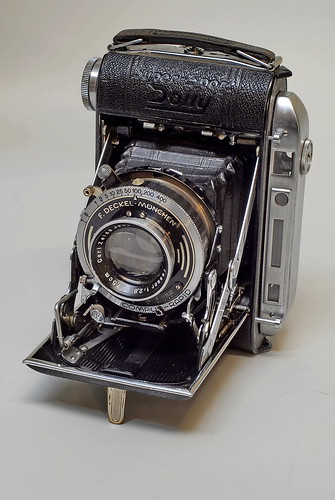Super Sport Dolly
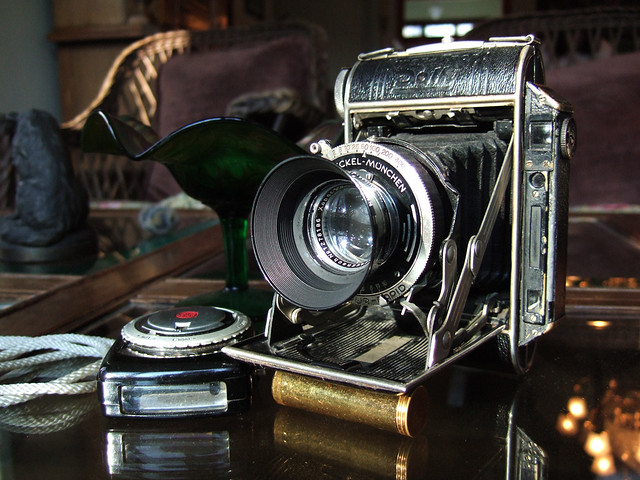
|
| Super Sport Dolly coupled rangefinder model with Xenar 7.5cm f/2.8 lens and Compur-Rapid shutter. image by Nesster (Image rights) |
The Super Sport Dolly is a self-erecting folding camera for 120 film, produced from about 1934 by the German maker Certo based in Dresden. The camera can make 4.5×6cm or 6×6cm images, by inserting the correct mask in the film chamber (either format requires a mask, which is combined with a pair of film rollers). Viewfinder and coupled rangefinder models were offered at the same time. There was a version of the camera which could also use 4.5×6 cm plates or a film-pack adapter; this also has a removable lens and shutter unit, allowing the use of an extension tube, or even exchangeable with a telephoto lens.
Contents
Viewfinder models

|
| US Certo brochure page, c.1938, showing the viewfinder model. scanned by rebollo_fr (Image rights) |
The viewfinder Super Sport Dolly has a folding reverse-Galilean viewfinder on the side (in most examples, it is on the left; McKeown states that late examples, after about 1939, have the finder on the right[1]). The finder may have frame-lines for the smaller format and/or red cross-hairs on the front glass (these are hard to keep in focus with the finder close to the eye; perhaps they are intended to be used with the camera at a distance from the eye, a kind of 'sports finder').
There is a hinged metal plate on the back (with a catch). This covers the red windows (three windows: two for the 4.5×6 cm format, and one for the square format), and carries a depth-of-field table. On the inside face of the plate is a wipe-clean card titled 'Notiz' (notes).
The camera has a tripod bush, and a folding table-stand on the folding front. The leatherette used varies between examples, but is sometimes quite elegantly decorated.
McKeown describes three models:
Model A
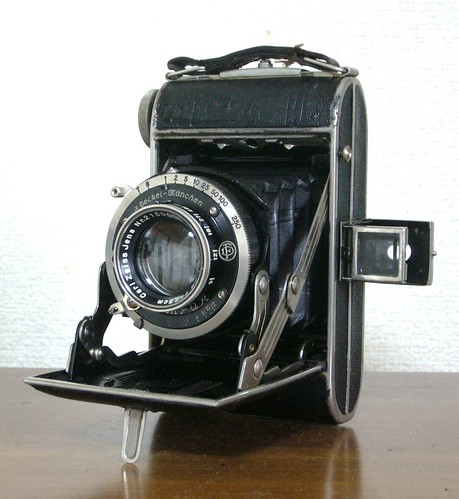
|
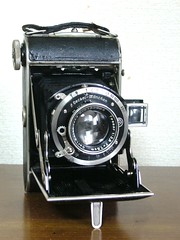 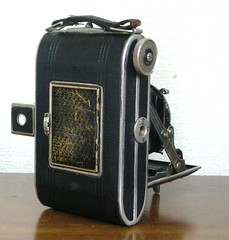
|
| Super Sport Dolly viewfinder model A, with front-element focusing Tessar 7.5cm f/2.8 lens and Compur shutter. Pictures by eBayer Yalluflex. (Image rights) | |
Model A is the basic model (though it can have a very high specification, like the example shown here). It has a fixed lens, and is for roll film only. It may have either front-cell focusing or unit focusing. These were the available lenses in a German brochure of about 1938:[2]
- Anastigmat Certar 7.5cm f/4.5 with Pronto shutter
- Friedrich Corygon 7.5cm f/3.5 with Compur shutter
- Steinheil Cassar 7.5cm f/2.9 with Compur
- Schneider Xenar f/2.8 7.5cm (this is the five-element Xenar) with Compur.
- Carl Zeiss Tessar f/2.8 7.5cm
- Meyer Görlitz Trioplan 7.5cm f/2.9 with Compur (this is probably the most commonly-seen lens; it is listed in the US catalogue shown at right, but not in the above-mentioned German catalogue)
Examples are also seen with other lenses and shutters.
Model B
Model B has a removable panel in the back to allow the fitting of 4.5×6cm plate holders, or a film pack adapter. The camera was supplied with three plate holders and a folding ground-glass screen. The surface of the plate would be further back than that of a roll film (outside the normal camera body), and there is a lever under the lens to adjust the position of the front standard for proper focusing for film ('F') or plates ('P').
The lens and shutter are attached to the front standard by a very simple hinged catch. When this is opened, the shutter can be lifted out. This is to allow the fitting of an extension tube for close-ups (focusing down to 27 cm with the standard lens[2]). This would be hard to use except with ground-glass focusing. It is also possible to fit an alternative lens; a 21 cm f/6.3 Plaubel Tele-Makinar was available (apparently in a Compur shutter).[2]
Some cameras have the film advance knob as pictured here, engraved with frame numbers 1-12 and with a pointer. Not all 120 film was at first marked with frame numbers for the square format, and this counter allows such films to be used (or simply removes the need to use the red window). The instructions given for the counter are as follows:[3]
- Load the film, and wind it until frame number 1 shows in the lower red window (for 4.5×6; recall there might not have been frame numbers for the 6×6 window)
- Set the counter to 1 (the instructions describe turning the dial set in the face of the knob; however, on some cameras, there is no dial; the numbers are engraved in the knob itself. In this case, the only way to set the counter is to wind to 1).
- For frames 2 - 10, give the knob one full turn, and then advance the frame number to the pointer.
- For frames 11 and 12, advance to the frame number without the full turn.
The 1938 brochure makes no mention of Model B; presumably the film-rewinding feature of Model C had become standard.
Model C
According to McKeown, Model C differs from Model B only in having the facility to rewind the film. The camera has both a plain film advance knob at the bottom, and the knob with the frame-counting engravings (described above) at the top. This allows a roll film to be rewound to switch to plates (or to switch to another type of film), and then reset to the correct frame later. The supply spool (i.e. unexposed film) is loaded at the bottom, and wound to the top, using the engraved knob. For normal use, the plain winding knob must be disengaged, by pulling it out and giving it a part-turn backwards (against the arrow); to rewind the film, the plain knob must be engaged, and the engraved one disengaged.

|
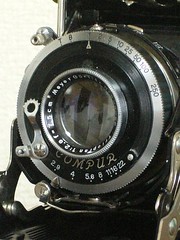
|

| |
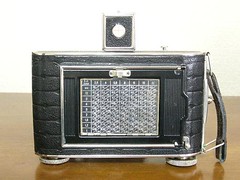
| |
| Super Sport Dolly viewfinder model C with Trioplan 7.5cm f/2.9 lens and Compur shutter. Pictures by eBayer Yalluflex. (Image rights) | |
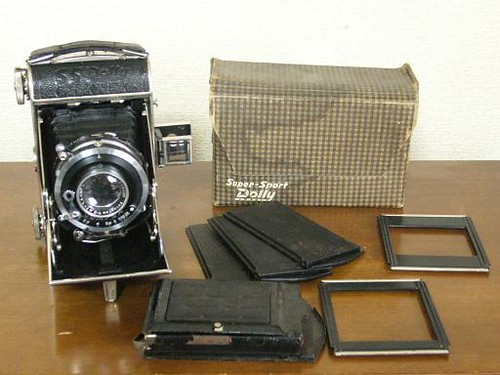
|
    
|
| Model C outfit, with film mask for each format, ground glass screen, plate holders and film pack adapter. Pictures by eBayer Yalluflex. (Image rights) |
 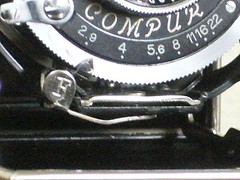
|
| Lever to adjust the front standard for plates or rollfilm. Pictures by eBayer Yalluflex. (Image rights) |
Rangefinder models
A version of the Super Sport Dolly with a coupled rangefinder was introduced in 1937.[1] It exists in both models A and C as described for the viewfinder camera. The rangefinder and an enclosed reverse-Galilean viewfinder are in a unit fastened on the left side of the camera. The rangefinder and viewfinder are not combined (i.e. the rangefinder spot is not visible in the viewfinder). There is a rotating mask to adjust the viewfinder for the two formats. From about 1938, the finder unit also incorporates an extinction lightmeter. There is then an interpretation table for this inside the panel covering the red windows, instead of the 'Notiz' card.
On most examples, the finder unit is black and trapezoidal in shape, and the shutter release is still on the shutter itself. Later, a finder unit with a silver metal housing was fitted. These cameras (rather less common; quite probably Wartime production) also have a body shutter release (as well as a knurled release tag on the shutter itself; see the picture below) and a restyled film advance knob.
The lens is either a Xenar or Tessar (uncoated); it always has unit focusing by a helical gear placed behind the shutter. The focus control is a lever above the shutter (the camera will only fold when this is close to infinity).
  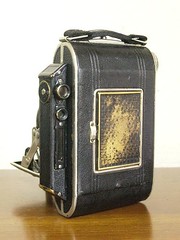
|
| Super Sport Dolly coupled rangefinder model A with 7.5cm f/2.8 Tessar and Compur shutter. Pictures by eBayer Yalluflex. (Image rights) |

|
| US Certo catalogue, c.1938, showing the rangefinder model. Scan by rebollo_fr (Image rights) |
|
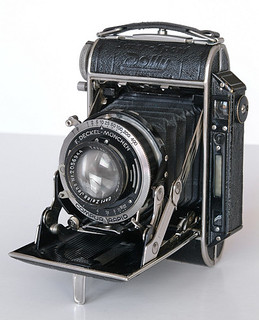 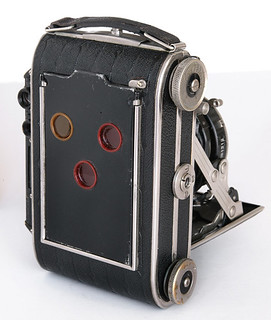 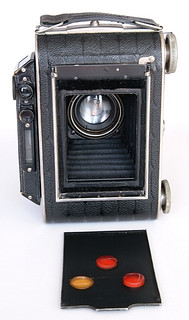
|
| 1938 Super-Sport Dolly Model C showing wind & rewind knobs and back removed for plate use images by Geoff Harrisson (Image rights) |
Notes
- ↑ 1.0 1.1 McKeown, James M. and Joan C. McKeown's Price Guide to Antique and Classic Cameras, 12th Edition, 2005-2006. USA, Centennial Photo Service, 2004. ISBN 0-931838-40-1 (hardcover). ISBN 0-931838-41-X (softcover). p199.
- ↑ 2.0 2.1 2.2 Certo Brochure issued by Photo Schaja of Munich; similar but not identical to the English-language from which pages are shown here (but in German). The brochure appears to state that helical focusing is only available for the Tessar and Xenar, with Model C of the viewfinder camera, and is the only option for the rangefinder model.
- ↑ User's manual for the Super Sport Dolly. Scanned pages as a Flickr Set in Dustin McAmera's photostream.
Links
- Super Sport Dolly manual in an album by Flickr member Dustin McAmera
- Super Sport Dolly, Model A review at Jim Grey's Down the Road
In French:
- Pages on www.collection-appareils.fr by Sylvain Halgand:
- Super Sport Dolly, viewfinder only, Tessar 7.5cm f/2.8, Compur
- Super Sport Dolly model C, viewfinder only, Trioplan 7.5cm f/2.9, Compur
- Super Sport Dolly model C, coupled rangefinder, Xenar 7.5cm f/2.8, Compur
